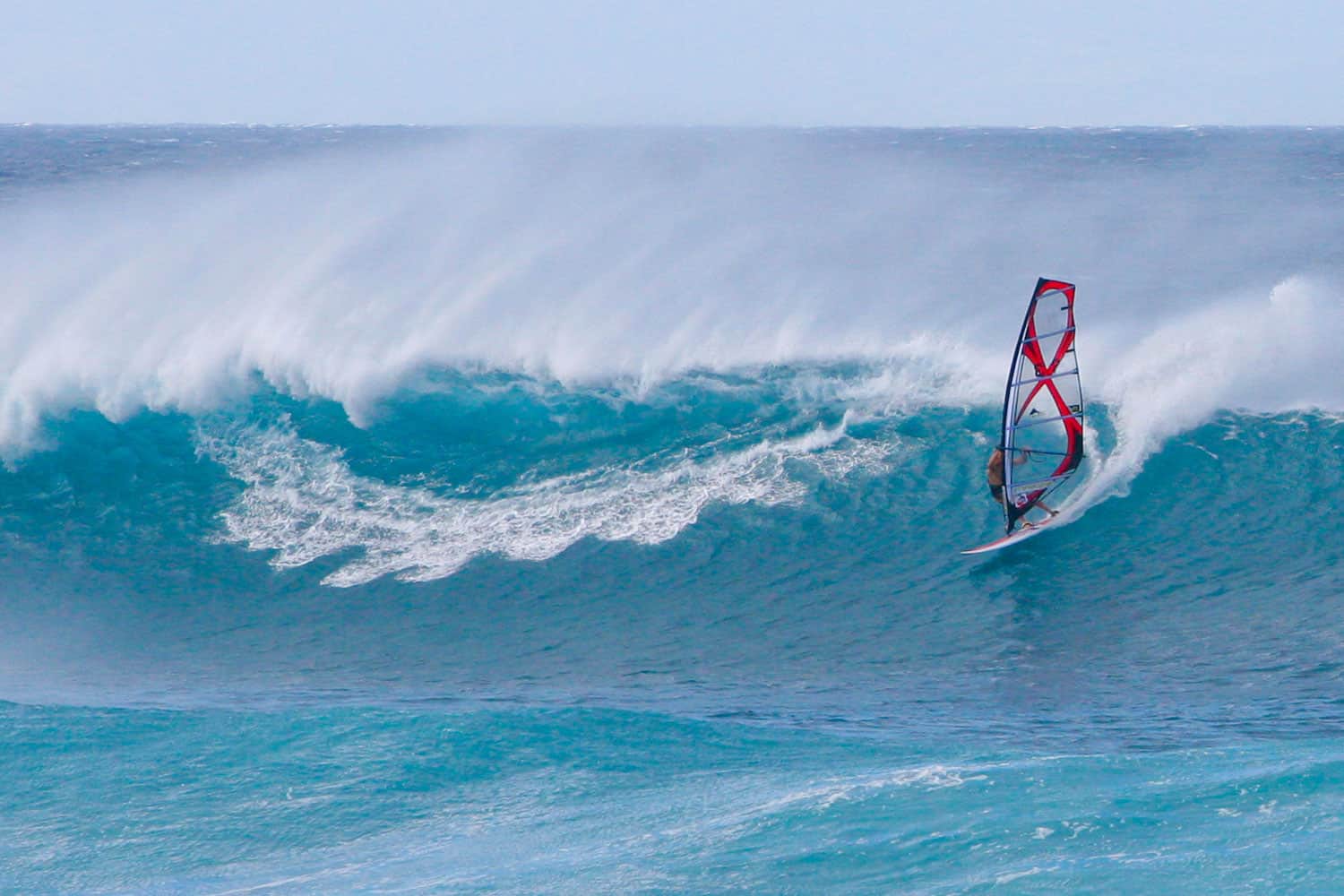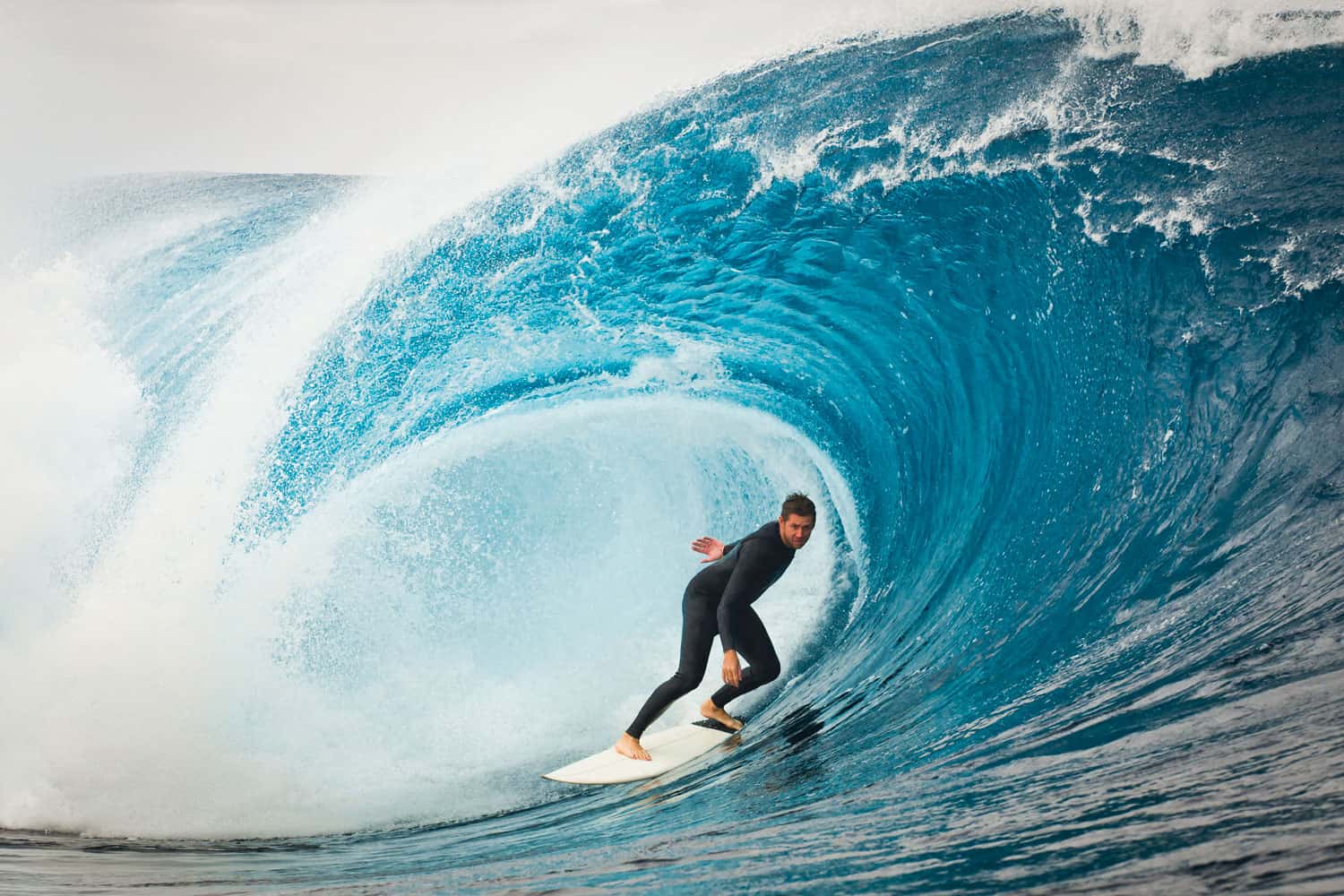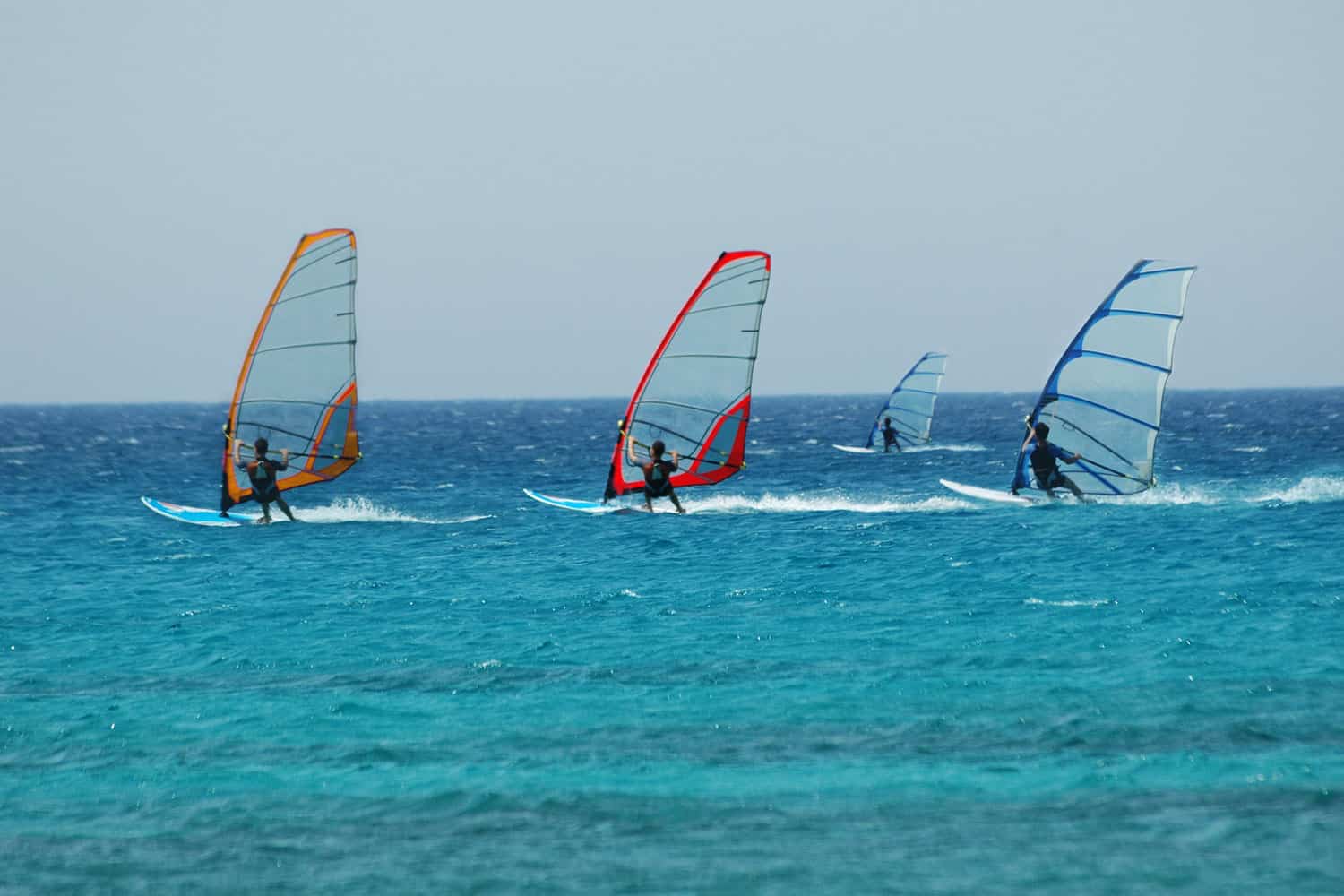Windsurfing and surfing are similar sports, but there are some key differences. We've researched these differences to help you understand the two sports and to figure out which one is right for you.
Both windsurfing and surfing use a board that uses momentum to glide on the surface of the water. The main difference between the two is how the momentum is created. In windsurfing, the wind catches a sail to move the board in your intended direction. In surfing, the board is moved by the surfer paddling it out into the water, then the waves pushing it back to the shore.
Below, we'll discuss these differences in detail, plus answer several questions that will help you know which sport you should pursue. Let's dive in!

Windsurfing Versus Surfing
Let's check out the differences between these two water sports.
Windsurfing

Windsurfing is a water sport that evolved out of surfing. A windsurfing board is similar to a surfboard, except it contains a sail and necessary rigging. Thus, it combines the principles of surfing with the mechanism of sailing to make for a full-body experience.
Like surfing, windsurfing requires standing on a board made out of foam and fiberglass. The windsurfer then holds on to the rigging and manipulates it to catch the wind, driving them in their intended direction.
Unlike surfing, windsurfing relies on the wind to make conditions favorable. In fact, you can windsurf on the water that is waveless, as long as there is enough of a breeze. Many people windsurf on lakes or bays to make the experience easier. This is because the board is powered by the wind in the sails and the windsurfer's ability to use the sail.
Surfing

Surfing is a classic sport enjoyed by people since the eighteenth century. There's no sail, mast, or rigging required: just the board and a tether. The surfer lays face-down on the board and paddles through the water to a spot where the waves break. Then, they stand up on the board and ride the wave's momentum to the shore.
The paddling process can be difficult since you have to avoid waves and often paddle long distances. Instead of relying on wind to take the board where you want it to go, the board is powered by the surfer's paddling and the waves' direction.
Which sport is right for you?
Most water sports experts say surfing and windsurfing each offer a different type of thrill. Windsurfing provides constant excitement: there's no paddling necessary, and you can go as long as the wind takes you. Surfing, on the other hand, requires steady patience, followed by a burst of excitement.
One way to think of the difference is to think of surfing as hunting and windsurfing as hiking through the woods. Hunting involves patiently waiting for an opportunity to attack the prey. Some people find the searching and waiting to be relaxing. On the other hand, windsurfing is a constant source of stimulation, like hiking through the woods. There's no waiting involved, but it also might not provide the same rush of adrenaline as firing a weapon at an animal.
Thus, if you're looking for a sustained form of excitement, you should choose windsurfing. If you're looking for a variety of patience and exhilaration, surfing might be best. Of course, there are numerous other things to think about, which we'll discuss below.
How much does windsurfing cost? Surfing?
Budget is another important part of choosing which sport to begin. Here's what you can expect to spend on each sport.
Windsurfing
Since windsurfing requires a board plus all the sailing equipment, it is more expensive than surfing. Plus, many windsurfers have multiple sails to use based on the conditions. All of the necessary equipment -- board, sail, mast, boom, mast extension, universal joint, uphaul rope, and harness -- might cost a couple of thousand dollars, depending on the equipment's quality.
Click here to view this windsurfing equipment on Amazon.
Surfing
On the other hand, surfing is cheaper to begin. You can find a beginner-level board for somewhere between $1,000 and $1,500, with boards for more experienced surfers costing more.
Click here to view this surfboard on Amazon.
Is Windsurfing Harder Than Surfing?
Choosing the more difficult of the two sports is challenging because it's based so much on personal preference. However, most people find windsurfing to be easier, as it requires less physical strength and stamina. Surfing is more strenuous because of the frequent paddling. It takes considerable strength to get yourself out to the right spot to enjoy surfing. Plus, learning the right spot and how to read the waves can be difficult.
On the other hand, windsurfing can be done on any water surface, even if it doesn't have waves, since the wind is what powers the board. This might make it easier to learn as you don't have to contend with waves. Many people find it easier to stand up on a windsurfing board since there's something to hang on for balance.
For more information on learning surfing, check out this article: "Is Surfing Easy or Hard to Learn? [Here Are the 6 Steps to Take]."
Is Windsurfing Or Surfing Faster?
Windsurfing is faster than surfing, depending on the conditions and how you're using your board. While you can windsurf on a smooth surface, many windsurfers prefer to allow the waves to power them, in addition to the wind. This gives you two sources of power, which will naturally increase your speed.
Like surfing, windsurfing is dependent on natural conditions, so it's difficult to predict how each day will go. However, if there's plenty of wind and waves, you'll reach high speeds. A windsurfer named Antoine Albeau set the record for the fastest speed on a windsurfing board at 55 knots, which is approximately 63 miles per hour!
Is Windsurfing Dangerous? Is Surfing Dangerous?
Windsurfing and surfing can be classified as extreme sports, which is used to describe any physically hazardous sport. A big reason that surfing and windsurfing are dangerous sports is that they depend on natural environments. Whenever you rely on unpredictable, natural elements as a part of the sport, you run the risk of those elements becoming dangerous.
Any sport that is performed in the water can be potentially dangerous. Whenever you're around water, you should be aware of the danger of drowning. Plus, when surfing or windsurfing, you're adding other equipment to the mix, which can lead to other injuries. Any injury suffered on the water can quickly become more dangerous than on land.
Safety Tips for Surfing and Windsurfing:
- Be vigilant and know your limits. A lack of awareness is the most dangerous part of water sports. While you're enjoying the exhilaration, make sure you're checking on your surroundings. Also, don't go past your comfort level. Going beyond your limits -- whether for depth, speed, or duration -- can lead to danger.
- Check your equipment before beginning. Are there any damaged materials? Does anything look incorrect? If so, get them fixed before going out on the water.
- Don't go out alone. It's always best to take a friend with you when you hit the water, so they can pay attention to you and help if something goes wrong.
- Don't go out in dangerous weather. Before you go to the water, check the forecast. If it looks dangerous or unpredictable, stay home. There are apps available specifically intended for surfing that will help you understand the wind patterns to stay safe.
- Only surf or windsurf in daylight. It might seem exciting to go out at night, but this increases your danger drastically.
- Wear a flotation device. This is especially true if you're a beginner or aren't a strong swimmer. This device could potentially save your life if you suffer an injury on the water. Below are a couple of life jackets you should check out if you need a device.
Click here to view this life jacket on Amazon.
Click here to view this life jacket on Amazon.
For more ideas on staying safe while surfing, check out this article: "Can You Wear A Life Jacket While Surfing?"
Can You Teach Yourself To Windsurf? Surf?

You can teach yourself how to windsurf and surf. There is a plethora of resources -- guides, videos, and books -- that can show you where to begin. As long as you put safety measures in place and understand surfing or windsurfing etiquette, you might enjoy teaching yourself how to use your board.
However, investing in lessons is the best way to make sure that you're learning good habits safely. Many training companies have dry-land simulators so you can learn the basics without the danger of the water. Instructors are trained in safety and technique, so you can be sure you'll be protected. Plus, instructors can help you make sure you have the right equipment so you don't have to guess at what's best.
Where Is Windsurfing Most Popular? Surfing?
Windsurfing and surfing are popular in any area where the weather is cooperative, and there's plenty of shorelines. Some areas are better for each sport than others.
Windsurfing is most popular on the Hawaiian island of Maui. This is where the greatest mix of weather, amenities, and community exists. It has also hosted most of the biggest windsurfing competitions throughout history. There are also fantastic windsurfing spots in Bonaire, the Columbia River Gorge, and the Canary Islands.
Surfing is also incredibly popular in Hawaii as well as California. However, Australia is another strong contender for the most popular surfing spot. Surfing was born in the South Pacific on islands such as Tahiti, Polynesia, and other Pacific Islands. In general, surfing is more popular than windsurfing, so you can find great surfing and surf culture anywhere around the world.
How Big Do Waves Need To Be To Surf?

Waves don't need to be huge to surf, especially if you're a beginner. Realistically, you can surf on waves as small as 1.5 feet high. However, as you get more experienced, you'll want the waves to be higher to get enough excitement out of surfing. This might mean waves anywhere from three to six feet high. Unless you're a professional, you'll want to stay away from waves higher than six feet high, as this means conditions are dangerous.
How Much Wind Do You Need To Windsurf?
It only takes a wind speed of about five miles per hour to windsurf. This is about the level at which you can feel the breeze on your skin, so it's not very fast. Beginners can probably handle wind up to fifteen miles per hour, while professionals can windsurf in conditions up to 35 miles per hour.
Can You Use A Windsurf Board To Surf?
You can surf on a windsurf board, but it will be more difficult than a board intended for normal surfing. Both styles of boards are similar in design, shape, and weight. However, the differences are what make switching surf types challenging.
Surfboards are somewhat smaller than windsurfing boards, so they're easier to maneuver. When you use the sail and rigging on a windsurfing board, you can rely on the wind to steer you. When you remove this equipment to surf, it's harder to steer.
In Closing
Windsurfing and surfing are both exciting water sports that use a board to allow you to glide on the water, but a few major differences separate them. Windsurfing harnesses the wind's power to move the board, while surfing requires paddling and using the waves. The results of these differences can help you choose which one is right for you.
Whichever sport you pursue, make sure to stay safe. Good luck!







![Read more about the article How Much Does It Cost to Go Bowling? [and Should You Buy Your Own Gear]](https://fitseer.com/wp-content/uploads/2020/10/Close-up-view-score-monitor-in-bowling-club-500x333.jpg)



That was a pretty average breakdown. I do both sports and I can tell you that windsurfing is a lot harder. Don’t get me wrong both sports are challenging but windsurfing is better! Surf can be chill with excitement but windsurfing is the same when you do it on the waves but from exciting to very bloody exciting.